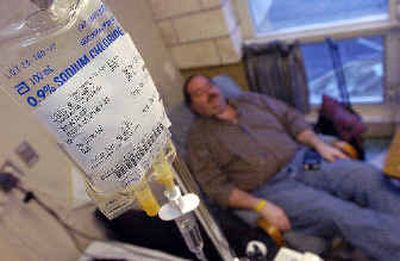Cancer drugs come with sticker shock

SAN FRANCISCO — In the two weeks since Genentech’s expensive new drug Avastin was found to help the sickest lung cancer patients live a few months longer than expected, investors have pumped nearly $17 billion into the company.
But what’s good for the patients, the company and its investors is also heavily stressing the ailing U.S. health care system, raising uncomfortable questions about the cost of end-of-life care.
“We are spending huge sums of money on treatments that are offering only modest benefits,” says Dr. Richard Deyo, a University of Washington professor who recently wrote a book on the subject.
The average annual premium for employer-sponsored family coverage will be $14,565 in 2006, more than double what it was in 2001, forecasts the National Coalition on Health Care, a Washington D.C.-based alliance of business, labor, religious and civic groups.
The ranks of the uninsured are rising as well, and lawmakers are looking for cuts to bring Medicare spending under control.
Much of the blame is being laid on prescription drug costs, which have spiraled from $12 billion annually in 1980 to $179 billion in 2003, according to the Center for Medicare and Medicaid Services.
Pricey new cancer drugs such as Avastin that help patients stay alive a few months more as well as dozens of other biotechnology drugs are more expensive to produce than traditional drugs because they are made from living cells, a new and radical departure from decades of manufacturing and regulatory practices that relied on well-known chemicals.
Deyo says these drugs contribute mightily “to the malaise in health care. It’s why health insurance costs are rising.”
Genentech and other industry supporters argue that when it comes to cancer, success is measured in the smallest of increments, and that the high cost of developing new treatments — about $850 million per drug on average — warrant the high price tags.
Doctors and their well-insured patients, meanwhile, are willing to try anything — and everything — for even a few extra days of life.
For the patients whose health insurance plans pay these astronomical costs, the drugs can seem heaven-sent. Who wouldn’t want two more months with loved ones before they die?
“The longer we can go increases the chances that more drugs will become available,” said colon cancer patient Richard Lewis.
Lewis is 45, a father of four and a high school counselor in Colstrip, Mont., 120 miles south of Billings. In August, doctors found that his colon cancer had spread to his lungs. He’s not expected to live much past 47. Still, the tumors in his lungs haven’t grown much since his diagnosis and he senses that he may yet live a little longer than expected.
He credits Avastin, which is covered by insurance.
“Avastin is pricey, but for me well worth it,” Lewis said. “For someone who does not have good insurance … I do not know how they would manage.”
Avastin, which is designed to choke the blood supply that feeds tumors, was the first drug of its kind to be approved by the Food and Drug Administration last year, after Genentech Inc. showed it extends the life of the sickest colon cancer patients by an average of about five months, with chemotherapy.